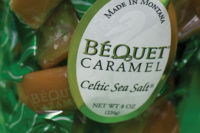When it comes to their ingredients and products, premium chocolate makers pride themselves on providing uncompromised quality.
“If someone is going to have just one piece of candy, we want it to be the best so that they enjoy it and look forward to the next time,” says Steven Hegedus, ceo and fourth-generation family owner of Abdallah Candies.
In that sense, Hegedus says, premium chocolates market themselves.
Abdallah Candies has seen a boom in sales stretching back to 2008 and 2009, right around the dawn of the recession. Hegedus attributes that spike to two things.
First, consumers saw premium chocolates as an affordable indulgence amidst other cost-cutting measures. Second, increasingly health-conscious consumers wanted food that made them feel good, had fewer additives and was made with quality ingredients.
Premium candies resonate with all of those desires. Made with top-quality ingredients, premium chocolates align better with healthier habits.
“Individuals may have started buying less chocolate, but they chose to buy better chocolate when they did indulge,” says Hegedus. “If they were going to have a small treat, they wanted quality — the best they could get for that money.”
But what really stands out about the premium chocolate market is the attitude of the makers themselves. Committed to taste first and foremost, they regularly evaluate ingredients, new recipes, and new combinations in order to offer the best-tasting, most relevant products consumers desire.
“Four generations ago, the first Abdallah customers came back to buy from my great grandfather not because we were the cheapest but because we had the best chocolate and the best products,” says Hegedus. “During the recession when many were cutting costs by cheapening their ingredients, we went the other way and upgraded our chocolate, nuts and fruits. It was the perfect time to widen the quality gap between us and our competitors.”
Although the competition is stiff, that focus on quality is instrumental in driving the growth of the market.
Competition within the premium chocolate set is strong, but even outside of it, chocolate makers compete with desserts, bakeries, standard chocolates, and artisanal chocolates, says Stu Haack, marketing manager, Ethel M. Premium chocolates are often used as gifts, so anything that can be bought in a similar price range could also be seen as competition.
But premium chocolate makers make their products the best they can be by using fresh ingredients and refining their chocolate over and over again.
“It’s a sense of pride that you have to take when you create a premium chocolate. And it’s knowing that every ingredient in that piece of chocolate that the customer just pulled out of the box is impeccable,” says Haack.
And competition can be a good thing.
There’s been a rise in specialty, artisanal chocolatiers in the last couple of years, which Haack thinks is great, because it’s forced premium chocolate makers to get back to their roots and innovate.
“You hear a lot of customers asking about ‘bean-to-bar’ and high cacao chocolate,” he says. “People are really getting into the craft of chocolate again, which to us, is a great thing. The most important thing is that, as chocolatiers, we’re all out there trying to create new and innovative high-quality products that get people excited about chocolate.”
Artisan chocolatiers can also introduce more exotic chocolates to consumers, trying them out on a smaller scale and priming the market for new products that can be manufactured on a larger basis once they’ve gained broader market acceptance, says Hegedus.
But that, of course, doesn’t mean premium chocolate makers aren’t trying out new things on their own. As Hegedus puts it, their job is to reach those who have yet to experience the premium market and convert them.
To that end, new flavors and combinations are constantly being tested.
Where artisan chocolate makers used to place more emphasis on the origins or the percentage of chocolate, there’s now more focus on creating unique flavors, says Michael Antonorsi, co-founder and master chocolatier, Chuao Chocolatier.
“Good is not ‘good enough’, because we remain dedicated to creating unforgettable palate experiences unlike any other chocolate brand today,” he says.
Based near San Diego, which Antonorsi calls a “Mecca for microbrews,” Chuao has paired chocolate bars with numerous kinds of liquor, from wine to local craft beer to single malt whiskey.
“Our mission is to bring joy to all by arousing the senses with delicious chocolate experiences,” says Antonorsi.
Coconut and seasonal flavors are also becoming popular. In addition to their 24 regular flavors, Abdallah Candies is working on seasonal ones like coconut spice, gingerbread and eggnog. More unusual pairings, like ancho chili and green tea truffles, are also in the works.
It’s about creating a broader mix of pairings, Hegedus says, and giving consumers a chance to individualize their chocolate purchases. Exotic combinations, spices, dried fruits, and nut pairings will tap into people’s desires for premium ingredients and healthfulness, while providing surprising flavor profiles.
At Ethel M, innovations into liquors and desert plants are in the works. But the key trend that Haack sees is a continued push toward healthier, sustainable chocolate.
“And by that, I don’t mean people want ‘Diet Ethel M,’” he says. “But I do think people want to feel better about their indulgences, whether that is telling them that your chocolate is preservative-free, fights signs of aging or is made with solar energy.”
Sustainability is certainly an important issue for premium chocolate makers. And it’s not just about the chocolate anymore.
Seattle Chocolates has committed to using Rainforest Alliance Certified chocolate and organic ingredients whenever possible. But more than that, they use suppliers that are dedicated to improving the communities of cacao farmers.
“Our suppliers implement training programs for cooperatives and farmers to teach them ways to improve efficiency and long-term sustainability,” says Jean Thompson, owner and ceo, Seattle Chocolates. “In addition, our chocolate suppliers are required to have progressive initiatives with cocoa farmers and non-governmental organizations who are on the ground in cocoa growing regions to monitor and influence the local and national governments to make important changes in their countries to eradicate child slavery and trafficking.”
They’ve also focused efforts at home in the United States. Seattle Chocolate’s recently-launched every chocolate gives campaign is committed to fighting hunger, donating a serving of fresh food to local food banks with every chocolate purchase made online.
“More than anything, I think people are going to fall in love with the chocolate that tells them a great story,” says Haack. “It’s up to the premium chocolatiers to find a way to tell our story more effectively. Because to us, the quality of our chocolate is unmatched, but we could do a better job of telling everyone why our chocolate is as interesting as it is delicious.”











